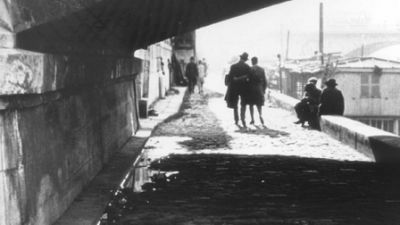
ÉTUDES SUR PARIS
(Francia/1928) R.: André Sauvage. D.: 80'
F.: Jean de Miéville, André Sauvage. M.: André Sauvage. Prod.: André Sauvage per André Sauvage et Cie DCP. D.: 80’. Bn. Didascalie francesi / French intertitles
Da: Carlotta Films
Restauro fotochimico effettuato da CNC – Archives Françaises du Film / Photochemically restored by CNC – Archives Françaises du Film. Restauro digitale effettuato dal laboratorio L’Immagine Ritrovata / Digital restoration by L’Immagine Ritrovata laboratory
Ritratti della Parigi degli anni Venti, eseguiti magistralmente con tratto rapido. Dai damerini dell’Opéra che chiedono informazioni a un vigile urbano […] ai ragazzi dei ‘bastioni’, con le bluse lacere e i volti ammaccati, scorre tutto un mondo scomparso. E a questi ragazzi della zona sorride da lontano il bébé Cadum, gigantesca réclame per la pelle dolce dei neonati. E c’è la Senna e le sue isole, Saint-Louis, la Cité, i lungosenna che danzano a filo d’acqua, visti dalla barca dove il cineasta si è installato per vederli meglio, un carrettiere bagna nella Senna il suo cavallo stremato […]. I lungosenna, ancora: un ragazzo scende una scala che conduce al fiume, una ragazza la scala opposta. La macchina da presa li ritrova in basso, ai bordi dell’acqua, ma il livello è salito e le scale non si congiungono più: ognuno risale dalla sua parte, due figure di spalle che suggeriscono la rassegnazione. Così si scrive, in tre piani e venticinque secondi, il romanzo di un amore e del suo lacerarsi. André Sauvage infatti non si accontenta di osservare. Immagina, prounga. Vive la sua Parigi. Questo film muto è pieno di vecchi romanzi, canzoni di strade e cortili, arie struggenti cantate da venditori di limonate. Potrebbe essere soltanto pittoresco, un vecchio album sfogliato, ma c’è di più. È la bellezza dei luoghi e di coloro che li abitano ad essere il soggetto di questo film: bellezza quotidiana del lavoro in un cantiere, del tonneggio di una chiatta, degli scambi al mercato, o del baluginare tremante di un riflesso sull’acqua, ma anche la sagoma cupa di una cattedrale inghiottita nell’acqua che si erge nella traversata notturna, sotto la Bastiglia, delle chiatte che lasciano il canale Saint Martin per la Senna e il bagliore di un sole immenso. Per non parlare dell’attenta composizione delle inquadrature […]. Perché questo film ha l’andatura spensierata di un pedone di Parigi, che passa da un quartiere all’altro, è nato dall’amore di esprimere le cose giuste. Pittore, poeta, Sauvage sapeva che ogni forma d’espressione deve avere il proprio linguaggio e aveva già riflettuto nei suoi film precedenti, purtroppo perduti, su quello che doveva avere il suo linguaggio. Da questo deriva la loro forza, ancora oggi intatta.
Emile Breton, Découvrir le Paris des années 1920, “l’Humanité”,
17 ottobre 2012
A portrait of 1920’s Paris, accomplished so majestically and crisply. From the dandies at the Opéra who ask a traffic policeman for directions […] to the kids hanging out at the bastions with tattered shirts and battered faces, an entire extinct world passes by us. And looming over these street kids the giant baby Cadum smiles from a distance, a giant billboard advertising the smooth skin of a newborn baby. There’s the Seine and its island, Saint-Louis; the Cité; the quays bobbing at the edge of the river; views from the riverboats, where the director installed his cameras to get a better angle; a cart driver washes his exhausted horse […] And again, along the Seine: a boy skips down the steps to the river, a girl at the same time on the opposite stairs. The camera finds them once again at the bottom, along the edge of the water, but the level has risen and the stairs no longer meet: each is rising on its own side, the two figures back to back suggesting a surrender. In three shots and twenty five seconds the story of a romance and its unraveling is told. André Sauvage is not content with mere observation, in fact. He imagines and prolongs and experiences his Paris. This silent film is full of old tales, songs of the streets and courtyards, and heartbreaking arias sung by lemonade vendors. It might have only been a picturesque old album to leaf through, but it’s more than that. It’s the beauty of the places and those who inhabit them that are the true subjects of this film: the beauty of a construction site, of a river barge and its cargo, of the bustling market, or the flickering reflections of the water; but also the gloomy shape of a cathedral churned up in the water, that emerges as a barge crosses through the night below the Bastille, coming out from the Saint-Martin canal into the Seine, and the brilliance of an immense sun – to say nothing of the impeccable attention to the composition of all of the images […]. With the thoughtful pace of a Parisian pedestrian, wandering from one neighborhood to another, it is born of the love of conveying all the right qualities. Painter and poet, Sauvage knew that every form of expression calls for its own language and he had already reflected, in his earlier films – now sadly lost – to what he owed this language. This is where his strength lies, and it still remains the case today.
Emile Breton, Découvrir le Paris des an- nées 1920, “l’Humanité”,
October 17, 2012
Tariffe:

Numero posti: 174
Aria Condizionata
Accesso e servizi per disabili
Il nostro cinema aderisce al circuito CinemAmico: è possibile utilizzare l’applicazione MovieReading® per i film di cui è prevista audiodescrizione e/o sottotitolazione sull'applicazione.
Tel. 051 2195311











